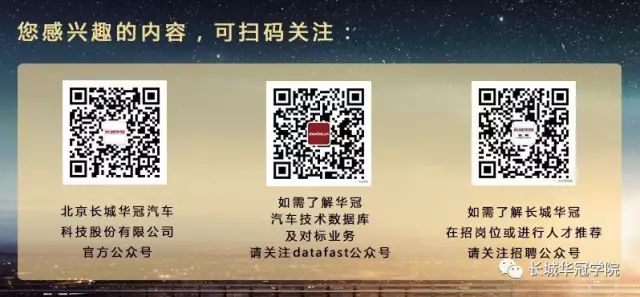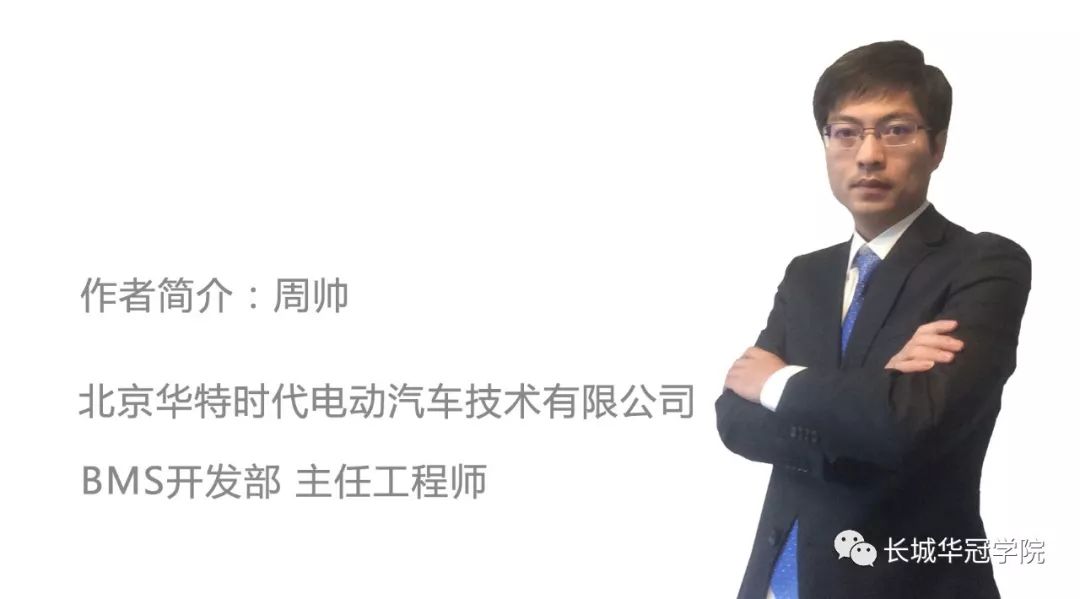
The definition of SOC (state of charge) varies widely, but a more unified international definition is based on capacity, representing the remaining capacity of the battery with SOC, which numerically equals the ratio of the remaining capacity Q to the maximum available capacity Qmax.

SOC estimation is one of the key technologies in battery management system (BMS) development and application, and the high accuracy of SOC estimation is often a highlight of corporate promotion. Simply put, SOC indicates how much electricity is left in the battery. SOC is the most important parameter in BMS because the control strategy for the entire vehicle, as well as the state estimations of battery SOH, SOP, SOE, etc., are all based on SOC. Therefore, its accuracy and robustness are crucial. Without precise SOC, it can easily lead to overcharging or over-discharging of the battery, severely affecting its lifespan and often leaving the battery in a protected state. Furthermore, the higher the SOC accuracy, the greater the range for batteries of the same capacity, thus high-precision SOC estimation can effectively reduce the required battery costs. Currently, there is extensive research on SOC estimation methods both domestically and internationally, but most methods are either not precise enough or not suitable for online estimation. For example, the discharge testing method is only suitable for offline SOC testing, while methods such as particle filtering, artificial neural networks, and fuzzy logic have too large a computational load for engineering applications. Below, we will introduce three SOC calculation methods that are suitable for engineering applications.
1. Ampere-Hour Integration Method
The ampere-hour integration method is currently the most widely used SOC estimation method in domestic battery management systems. Its principle is to estimate the SOC of the battery by accumulating the amount of electricity charged or discharged during the charging and discharging process, and correct the battery SOC based on the condition when the battery reaches full charge or after a certain period of static conditions. If we define the SOC value at the initial state of the battery during charging and discharging as SOC(0), then the remaining capacity SOC after time t can be expressed as:

Compared to other SOC estimation methods, the ampere-hour integration method is the simplest and can be easily transplanted to different BMS for estimating the SOC of different batteries without the need for extensive parameter adjustments, hence its widespread use. However, the ampere-hour integration method has the following issues:
First, the ampere-hour integration method relies on the initial SOC value. If there is an error in the initial SOC, it cannot be corrected during driving;
Second, there is the issue of accumulated error. Due to insufficient accuracy of the current sensor, low sampling frequency, and signal interference, the actual current I collected has a certain error from the true value, and this error accumulates over time, leading to an increasing error in SOC. To eliminate the accumulated error, it is necessary to correct the SOC, but this is not feasible during actual electric vehicle operation based on the battery reaching full charge conditions or static conditions after a certain period, thus reducing the practicality of this method;
Third, it cannot address the self-discharge issue of the battery. Almost all batteries have a self-discharge issue, where the charge in the battery is released at an extremely slow rate, resulting in very small currents that the current sensor cannot accurately measure, or the self-discharge current does not flow through the working current loop, making it impossible for the current sensor to detect. Moreover, precise collection of the current flowing into or out of the battery is needed to minimize estimation errors;
Fourth, it cannot cope with errors caused by changes in battery capacity. The capacity of the battery decreases as it ages and varies with temperature changes. In practical applications, it is necessary to incorporate other methods to estimate the maximum available capacity in real-time to ensure that the accuracy of ampere-hour integration does not decrease with battery temperature or aging.
2. Kalman Filtering Method
Unlike the ampere-hour integration, the Kalman filtering algorithm is a closed-loop estimation method that is suitable for computation at any time and does not require long periods of static conditions to obtain static OCV for SOC correction. It can eliminate the impact of insufficient sensor accuracy on SOC estimation and suppress noise that follows a normal distribution. Therefore, it is widely used in battery SOC estimation. The Kalman filter was proposed in the 1960s by Hungarian-American mathematician R.E. Kalman, who integrated state space analysis methods into filtering theory. Since its inception, the Kalman filter, as an optimal state estimation method, can be applied to dynamic systems affected by random disturbances. Specifically, the Kalman filter is essentially a recursive algorithm that can provide linear, unbiased, and minimum variance optimal estimates of system states based on discrete observation data that is subject to noise interference. Therefore, the Kalman filtering algorithm is not only suitable for dynamic random processes, but also enables recursion by predicting new states and their uncertainties, and then using new measurement values to correct the predicted values, making it very suitable for multi-input systems. The specific implementation process is as follows:
Determine Battery Model:

Determine State Equation:
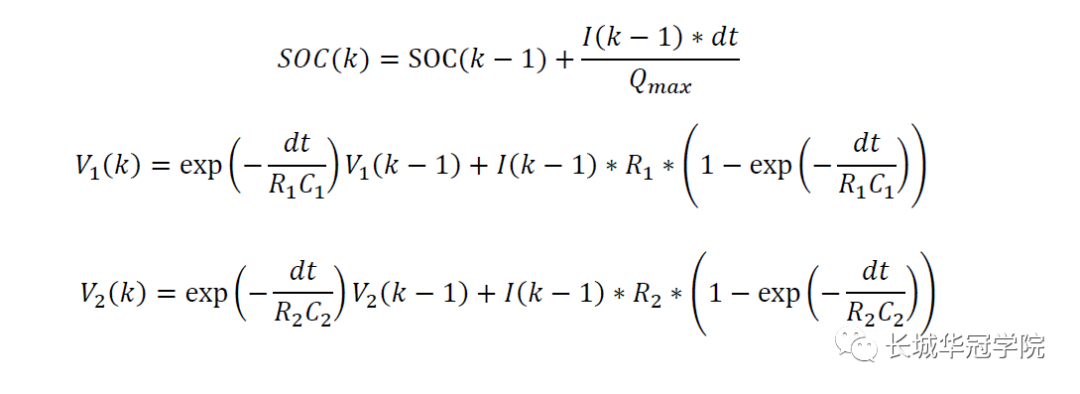
Determine Measurement Equation:

Using the Kalman filtering algorithm, the state variable SOC can be estimated in real-time, as shown in Figure 1 (where the green line RealSoC represents the true SOC value, the blue line UKFSoC represents the SOC value estimated using the unscented Kalman filter, and the red line DeltaSoC represents the estimation error of the unscented Kalman filter SOC). Under the condition that the initial SOC error is 0, the SOC estimation error using the unscented Kalman filter is close to 0. Figure 2 illustrates that the Kalman filter has strong robustness against initial SOC errors. Under the condition of a given 50% initial SOC error, the unscented Kalman filter SOC can quickly converge to the true SOC value.
Figure 1
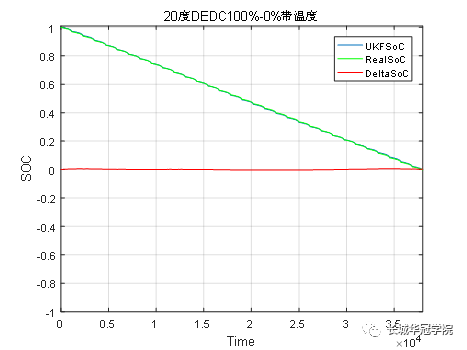
Figure 2
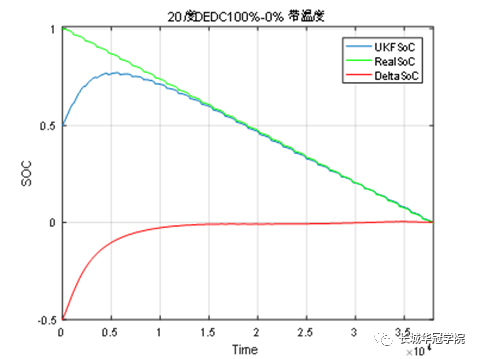
Based on the characteristics of lithium-ion batteries, there is a corresponding relationship between the open-circuit voltage OCV and SOC. OCV is the steady-state voltage of the battery measured under open-circuit conditions, and the relationship between SOC and OCV can be obtained through offline testing.The SOC estimation method based on ampere-hour integration requires an accurate initial SOC value, high-precision current sensors, and high-frequency current sampling, which are difficult to obtain during the actual operation of electric vehicles. On the other hand, the SOC estimation method based on Kalman filtering requires a large battery database, occupying significant storage space, making it hard for systems using low-processing-capacity MCUs to meet real-time requirements.The OCV-based estimation method, under the condition of not needing to establish a large battery database or requiring high-performance processors, can estimate battery OCV in real-time to correct SOC, ensuring high accuracy and robustness of SOC estimation.The specific implementation process is as follows:
Determine Battery Model:

Establish Terminal Voltage Differential Equation:

Where:

Let:

Using the forgetting factor recursive least squares method, the parameter θ can be estimated, and the OCV can be calculated as follows:

The SOC of the battery can be calculated as follows:

Where the SOC calculated by ampere-hour integration is the SOC obtained after estimating the OCV from the lookup table, and w is the weight determined based on operating conditions.
Figure 3
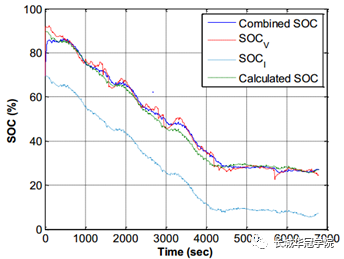
Figure 3 is an example of validating SOC, where Calculated SOC is the true SOC value, which is the SOC calculated from the lookup table after estimating OCV, and is the SOC calculated by the ampere-hour integration method. CombinedSOC is the SOC calculated by weighted computation. As shown in the figure, under the condition of initial SOC error, the ampere-hour integration method cannot correct it, while the OCV-based estimation method can quickly correct the initial error and approach the true SOC value.

